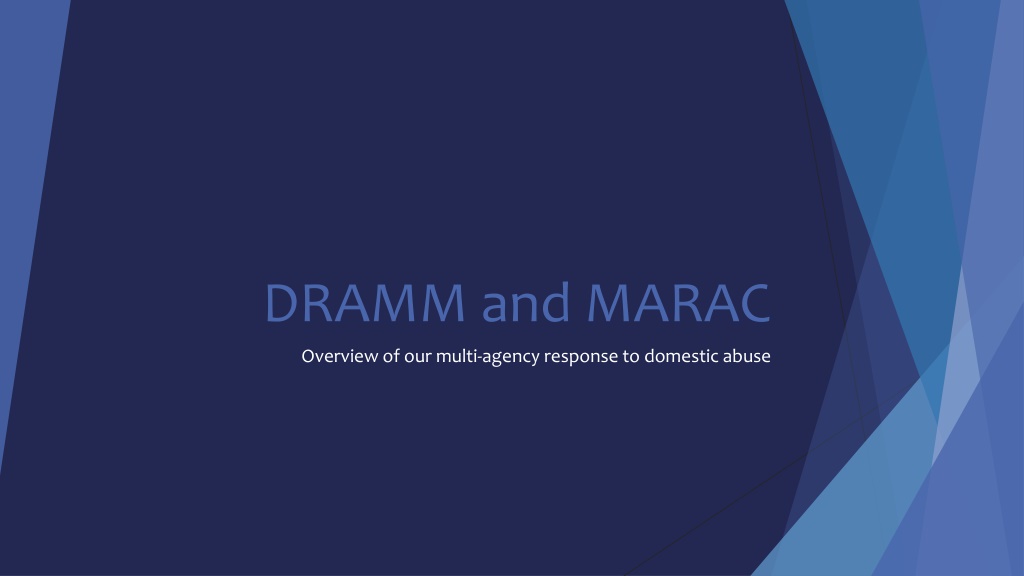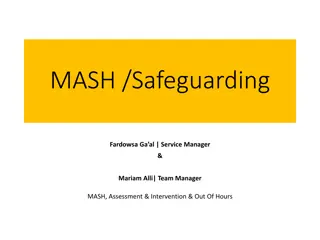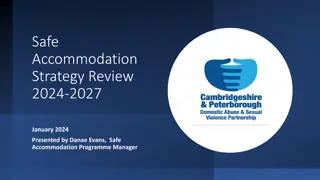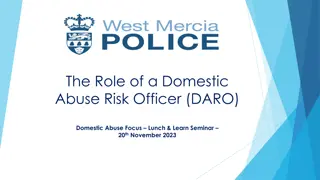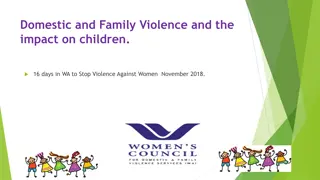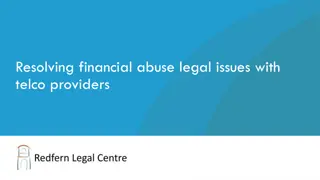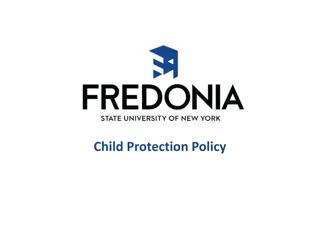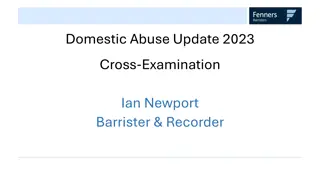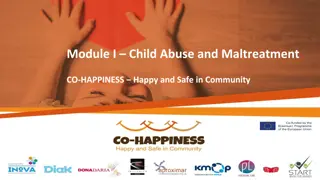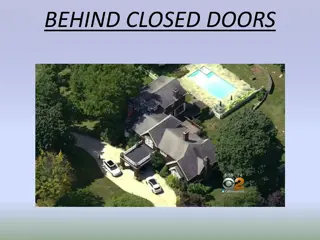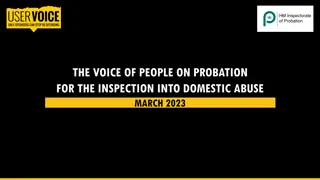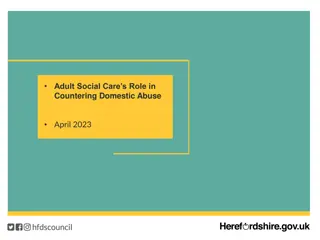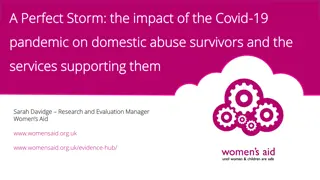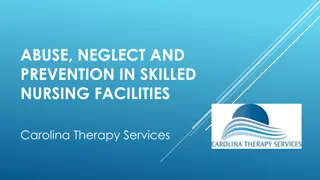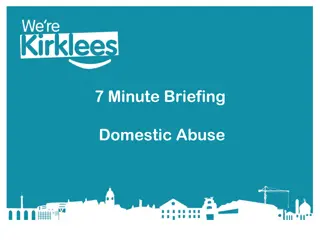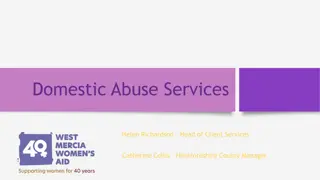Understanding Multi-Agency Response to Domestic Abuse
Explore the comprehensive approach of multi-agency response to domestic abuse, covering risk assessment, immediate support, and information sharing. Learn about assessing risk levels, indicators, and potential harm scenarios in domestic abuse cases through real-life examples and checklists. Gain insights into recognizing patterns of abuse and controlling behaviors, and the significance of safeguarding vulnerable individuals.
Download Presentation

Please find below an Image/Link to download the presentation.
The content on the website is provided AS IS for your information and personal use only. It may not be sold, licensed, or shared on other websites without obtaining consent from the author. Download presentation by click this link. If you encounter any issues during the download, it is possible that the publisher has removed the file from their server.
E N D
Presentation Transcript
DRAMM and MARAC Overview of our multi-agency response to domestic abuse
Risk assessment in domestic abuse cases Immediate safeguarding/support Consent and Information Sharing Briefing Overview Our multi-agency response to domestic abuse Operation Encompass Standard risk screening DRAMM MARAC
Introduction This briefing assumes a basic awareness of domestic abuse Basic awareness training is available via the KSCP: https://kirklees.event-booking.org.uk/elearning-detail/%3D%3DQO1gjN/Domestic- Abuse This briefing includes content some participants may find distressing. Domestic abuse is so prevalent that participants are likely to have witnessed the impact of domestic abuse on families and individuals they are working with and people they are connected to in their personal lives. If there is any content in this course that has caused you some distress, whether due to professional or personal circumstances, please get in touch with your line manager or the organisers of this course to discuss.
Domestic Abuse, Stalking and Harassment risk indicator checklist (available from: https://www.kirklees.gov.uk/beta/adult-social- care-providers/multi-agency-risk-assessment- conference.aspx) Developed by reviewing domestic homicides and identifying common elements How do we assess risk in domestic abuse cases? Developed by Police, and widely used by other agencies (including domestic abuse specialists) to assess risk 14 or more ticks yes indicates high risk BUT more important to consider what rather than how many Strangulation, use of weapons, rape, coercive control, stalking post separation all indicative of high risk
Level of risk What will DA in this case look like? Standard No pattern of abusive behaviour, or control of one person by another. No indicators of serious harm. What level of risk? Medium Pattern of abuse and/or control of one person by another, and/or physical violence. Potential for serious harm but sufficient safeguards in place. High Coercive control and/or frequent or very severe violence. Significant risk of harm, could occur at any time and have serious consequences.
Billy has disclosed feeling depressed due to recent separation. Issues with child contact. Baby is 8 months old. They are struggling with money as Sally has issues with class a drugs. She has a criminal history. 7 ticks yes on DASH Case example 1 Standard risk - no pattern of abusive behaviour, or control of one person by another. No indicators of serious harm.
Jane has disclosed that she has been strangled and threatened with knife during an assault by her partner when she tried to end the relationship. John says that he will kill her if she ever leaves him. She is isolated from friends and family and John controls everything she does. 6 ticks yes on DASH Case example 2 High risk - Coercive control and/or frequent or very severe violence. Significant risk of harm, could occur at any time and have serious consequences.
If you are not sure how to respond to disclosures or reports of domestic abuse, please access the domestic abuse e-learning on the KSCP website. At a minimum, professionals should be aware of own agency procedures to: Immediate safeguarding Report crimes to police Report concerns about children to Duty and Advice Safeguard vulnerable adults by contacting Gateway to Care Professionals can also: Seek support from PDAP Make a referral to DRAMM-MARAC
Consent Decision to contact police or social care is based on risk assessment NOT consent Good practice to obtain consent where appropriate It may not be appropriate to seek consent if it would: place a child at risk of significant harm; place an adult at risk of serious harm; prejudice the prevention/detection of a serious crime; and/or delay enquiries about allegations of significant harm. Always record your rationale for sharing information without consent
Our multi-agency response to domestic abuse Kirklees agencies have established a number of processes to respond to domestic incidents that are reported to Police. Level of risk What will DA in this case look like? Multi-agency response Screening by Police and CSC Signposting to services Immediate information sharing with schools through operation encompass Standard No pattern of abusive behaviour, or control of one person by another. No indicators of serious harm. Immediate multi-agency risk assessment and safety planning through DRAMM Immediate information sharing with schools through operation encompass Medium Pattern of abuse and/or control of one person by another, and/or physical violence. Potential for serious harm but sufficient safeguards in place. Immediate multi-agency risk assessment and safety planning through DRAMM Follow up at MARAC within 2 weeks Immediate information sharing with schools through operation encompass High Coercive control and/or frequent or very severe violence. Significant risk of harm, could occur at any time and have serious consequences.
Information sharing between police and childrens social care Police attend a domestic incident and children are present or otherwise linked Information about incident shared with Duty and Advice Screening standard risk incidents Police officer and social worker review incident against history recorded on both systems Decision to: Signpost family to relevant support Share information with allocated worker Escalate to DRAMM or Duty social worker
Information sharing between police and schools Police attend a domestic incident and children are present Information about incident shared with Education Safeguarding Operation Encompass School identified and contact made with Designated Safeguarding Lead DSL to consider appropriate liaison with class teacher and support that may be required i.e. breakfast, uniform, meet and greet, silent support, homework, scripts, quiet space, peer support, helping children talk, what to say if they disclose
Police incidents Any police incident assessed as high risk will automatically be referred to DRAMM A police incident assessed as medium risk where children are believed to be affected will be discussed at DRAMM A police incident assessed as medium risk where the victim has consented to information sharing will be discussed at DRAMM Making a referral to DRAMM This includes cases where professionals from other agencies have contacted police Other agency referrals Professionals may also wish to refer directly to DRAMM-MARAC DRAMM-MARAC does not replace other safeguarding processes and cases may not be heard immediately. Concerns should always be reported separately to Police and social care
DRAMM-MARAC referral form Available from: https://www.kirklees.gov.uk/beta/adult-social-care-providers/multi-agency- risk-assessment-conference.aspx Referrer details: who do we contact for further information and to arrange dialling in to DRAMM meeting Details of victim, perpetrator and any children, including details of their relationships to each other Information regarding consent crucial that you advise us if perpetrator is not aware that a disclosure has been made Reason for referral - what has happened to prompt you to make referral, be as specific as possible regarding risks, when incidents may have occurred etc Action already taken to ensure DRAMM does not duplicate any work you have already done
Daily Risk Assessment Management Meeting (DRAMM) DRAMM provides early opportunity for partner agencies to safeguard people from domestic abuse Professionals meet daily (Mon-Fri) at 11:ooam to discuss incidents that occurred within last 24 hours, so agencies can take immediate action to safeguard in medium and high risk cases. MARAC Referrals Police Incidents Medium & High MARAC repeats, transfers from other areas, Clare s Law DRAMM WY Police, Children s Social Care, Pennine Domestic Abuse Partnership, CHART and Locala meet to share information, assess risk and set actions to safeguard victims and their children
Review referral Does it include details of crime or child protection concern? Share information held on agency systems about victims, perpetrators and any children linked. Includes current involvement/relevant history Review risk assessment in light of information shared medium or high? Safety plan: DRAMM will: WY Police to progress criminal investigation PDAP/ASC to contact and offer support Duty and Advice to undertake assessment /offer early help Locala to task health visitor/school nurse CHART to contact and offer support Refer to MARAC
Case example 2: Jane disclosed that was strangled and threatened with knife during an assault by her partner when she tried to end the relationship. John says that he will kill her if she ever leaves him. She is isolated from friends and family and John controls everything she does. Information shared at DRAMM: Police victim reported via 999 following the assault. Perpetrator currently in custody. PDAP not previously known to us but we can contact whilst he is in custody. CSC John has a daughter that lives with her mother, not sure how much contact he has with her. Locala nothing relevant on John s daughter s health record CHART he is known historically for drug use but not currently open
Action plan from DRAMM Risk to: Risk-Context Existing Safeguards Further action required Jane has disclosed CCB and significant assault including strangulation Perpetrator is currently in custody, ongoing police investigation PDAP to contact her whilst he is in cells Victim John has a child with an ex-partner, his level of contact with this child is not clear Child does not live in home with either victim or perpetrator and was not present during the incident Child CSC to contact child s mother to make her aware of incident and explore contact with the perpetrator He has historically had issues with substance misuse CHART to contact him in the cells Perpetrator Risk assessment at DRAMM: Significant assault and CCB, strangulation and use of weapons high risk Referral to MARAC
Multi-Agency Risk Assessment Conference (MARAC) Fortnightly professionals meeting for high risk cases referred by DRAMM Not statutory, but every local authority area has one Cases to be discussed are shared with agencies prior to the MARAC meeting: All details provided in agency referrals Information shared as part of the DRAMM Existing risk assessment and safety plan
Police Independent Domestic Abuse Service Children s social care Locala Education Safeguarding Kirklees Neighbourhood Housing MARAC agencies Housing Solutions Probation & CRC Adults Social Care Substance Misuse Community Mental Health Team Hospital Trusts Victim Support Refuge
If you are working with someone who will be discussed at MARAC, your designated representative may ask you to provide: details of current work and recent contact, meetings, sightings, phone calls, attendance or non-attendance at appointments and/or who is present during home visits and appointments; What information will MARAC need from me? relevant historic information regarding previous work, family or relationships history, other safety options considered or any risks to professionals; other information relating to the risks facing the victim or other individuals that may be affected or at risk from the perpetrator.
MARAC Meetings Always start at 9:30am on a Thursday The Chair will remind attendees of the confidentiality statement The Chair will review outstanding actions from the last meeting Cases will then be discussed in the following order: MARAC repeat (further high risk incident within 12 months) with no existing safeguards in place New cases with no existing safeguards in place New cases with safeguards in place (i.e. victim in refuge, perpetrator in custody) MARAC repeat with safeguards in place (i.e victim reporting incidents/engaging with support) Domestic Violence Disclosure Scheme (Clare s Law)
MARAC Local agencies meet every fortnight to share information held on agency systems about victims, perpetrators and any children linked. The meeting builds on the work done by the DRAMM and may result in further actions to improve victim safety, including: Information sharing Flagging files for victim/children so that professionals are aware of history and respond appropriately to future incidents Safeguarding Children Information to be shared with social worker/relevant professionals Supporting Victims Support around DV, through either PDAP or agency already working with victim Managing Perpetrators Criminal process Integrated offender management Perpetrator programmes Professional with established relationship to start single assessment/ offer support Support around substance use, housing, mental ill health, sexual exploitation. Information shared outside of MARAC Support around substance use, mental health, housing Professionals meeting
Case example 2: Jane disclosed that was strangled and threatened with knife during an assault by her partner when she tried to end the relationship. John says that he will kill her if she ever leaves him. She is isolated from friends and family and John controls everything she does. Information shared at MARAC: Police John was arrested and released with bail conditions not to contact or attend her address. PDAP Jane is being supported by PDAP. He has not contacted her since the bail conditions were put in place, but she is really anxious that he will. She feels depressed. CSC John does not have any contact with his daughter, her mother disclosed domestic abuse in her own relationship with John, she ended it and stopped contact when she felt her daughter might be affected. Education safeguarding child is a little withdrawn, but achieving well academically CHART John is back in service with CHART. KNH there has been some complaints about anti-social behavior at the property, now that we know it may be related to domestic abuse we can support her to make the property more secure. CMHT she is not known, but if she wants some support with her mental health she can contact her GP or Single Point of Access
Action plan from MARAC Risk to: Risk-Context Existing Safeguards Further action required Jane has disclosed CCB and significant assault including strangulation. She fears that he will contact her again. Reports of anti-social behaviour at property. She is engaging well with PDAP KNH to contact Jane and consider how they can make her property more secure. Victim Jane has reported feeling depressed and really anxious PDAP to signpost her to her GP/SPA MARAC to share information with her GP Victim John has a child with an ex-partner, she is reported to be a little withdrawn Child has no contact with father, her mother is now aware of domestic abuse in his current relationship Education Safeguarding to talk to school about pastoral support for child and explore impact of earlier domestic abuse. Consider early help support if required Child John committed a nasty assault and subject Jane to coercive controlling behaviour. He has issues with substance misuse He has bail conditions not to contact her, police investigation is ongoing. No further actions Perpetrator He is now in service with CHART No further actions Perpetrator All agencies to flag files for victim and child to ensure any further disclosures are referred back to DRAMM. CHART to be aware of his perpetrator behaviour and sensitively explore as part of their ongoing work.
Information Sharing Professionals can use information shared through DRAMM-MARAC to deliver services to victim/children Extraordinary care should be taken to ensure perpetrator is not made aware of safety plan Information cannot be shared with any 3rd party without consent of MARAC Chair DRAMM-MARAC is not a legal entity and does not own information that is shared with it Information sharing protocol available from: https://www.kirklees.gov.uk/beta/adult-social-care-providers/multi-agency-risk- assessment-conference.aspx
MARAC Referrals/Process 07977 986744 or 01924 482112 Police Information/Advice Crimes to be reported via 101 or 999 in an emergency Contact Numbers Safeguarding Unit 01924 335073 Hub at Pennine Domestic Violence Group 01484 308306/7 0800 052 7222 (24hr hotline)
Worried about a child? If you think a child in Kirklees is being abused or mistreated or you have concerns about a child s well-being you should call and speak to someone at one of the following numbers: All calls concerning worries about children are treated seriously. You will be asked where the child lives and who looks after the child. Enquires will be made and if it is found that a child is being abused or is at risk of significant harm professionals will work together with the family to ensure that the child can be protected. Kirklees Children Services leaflet A Brief Guide to Reporting child abuse in Kirklees contains more information.
Report abuse or neglect of an adult at risk If an adult is in danger first ensure the individual is safe. Call the emergency services if immediate help is needed. If you are concerned that an adult at risk living in Kirklees is being abused you can telephone, visit or email: Contact Gateway to care 01484 414933 gatewaytocare@kirklees.gov.uk Customer Service Centre, Civic Centre 3, Market Street, Huddersfield, HD1 2YZ
